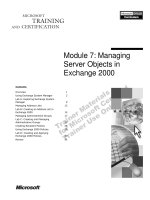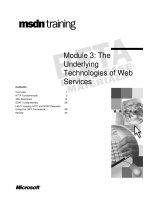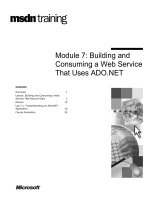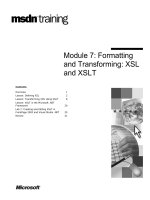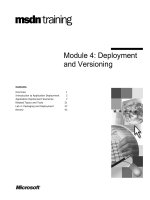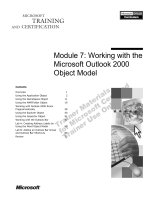Tài liệu Module 7: Building and Consuming a Web Service That Uses ADO.NET ppt
Bạn đang xem bản rút gọn của tài liệu. Xem và tải ngay bản đầy đủ của tài liệu tại đây (909.29 KB, 34 trang )
Contents
Overview 1
Lesson: Building and Consuming a Web
Service That Returns Data 2
Review 15
Lab 7.1: Troubleshooting an ADO.NET
Application 16
Course Evaluation 25
Module 7: Building and
Consuming a Web Service
That Uses ADO.NET
Information in this document, including URL and other Internet Web site references, is subject to
change without notice. Unless otherwise noted, the example companies, organizations, products,
domain names, e-mail addresses, logos, people, places, and events depicted herein are fictitious,
and no association with any real company, organization, product, domain name, e-mail address,
logo, person, places or events is intended or should be inferred. Complying with all applicable
copyright laws is the responsibility of the user. Without limiting the rights under copyright, no part
of this document may be reproduced, stored in or introduced into a retrieval system, or transmitted
in any form or by any means (electronic, mechanical, photocopying, recording, or otherwise), or
for any purpose, without the express written permission of Microsoft Corporation.
Microsoft may have patents, patent applications, trademarks, copyrights, or other intellectual
property rights covering subject matter in this document. Except as expressly provided in any
written license agreement from Microsoft, the furnishing of this document does not give you any
license to these patents, trademarks, copyrights, or other intellectual property.
2001-2002 Microsoft Corporation. All rights reserved.
Microsoft, MS-DOS, Windows, Windows NT, Win32, Active Directory, ActiveX, BizTalk,
IntelliSense, JScript, MSDN, SQL Server, Visual Basic, Visual C#, Visual C++, Visual J#, Visual
Studio, and Windows Media are either registered trademarks or trademarks of Microsoft
Corporation in the U.S.A. and/or other countries.
The names of actual companies and products mentioned herein may be the trademarks of their
respective owners.
Module 7: Building and Consuming a Web Service That Uses ADO.NET iii
Instructor Notes
This module teaches students how to build a simple Web service that queries a
database. It also explains how to consume the Web service in a client
application.
After completing this module, students will be able to:
!
Build a Web service.
!
Consume a Web service in a client application.
!
Troubleshoot errors in a Microsoft
®
ADO.NET application.
The lab for this module is optional.
To teach this module, you need the following materials:
!
Microsoft PowerPoint
®
file 2389B_07.ppt
!
Module 7, “Building and Consuming a Web Service That Uses ADO.NET”
!
Lab 7.1, “Debugging a Windows Application and an XML Web Service
That Uses ADO.NET”
To prepare for this module:
!
Read all of the materials for this module.
!
Complete the practices and labs.
!
Read the latest .NET Development news at
/>d=28000519
This module contains code examples that are linked to text hyperlinks at the
bottom of PowerPoint slides. These examples enable you to teach from code
examples that are too long to display on a slide. All the code examples for this
module are contained in one .htm file. Students can copy the code directly from
the browser or from the source, and paste it into a development environment.
To display a code sample, click a text hyperlink on a slide. Each link opens an
instance of Microsoft Internet Explorer and displays the code associated with
the link. At the end of each example is a link that displays a table of contents of
all examples in this module. After you have finished teaching the code for an
example, close the instance of the browser to conserve resources.
If time constraints occur, one or more practices in this module can be presented
as instructor-led demonstrations.
Presentation:
30 Minutes
Lab (optional):
120 Minutes
Note
Required materials
Preparation tasks
Hyperlinked code
examples
Practices
iv Module 7: Building and Consuming a Web Service That Uses ADO.NET
Use Microsoft SQL Server
™
Query Analyzer to run the SQL script named
setuplab7.sql in the Lab07 folder on the Instructor computer. This will create a
copy of the Employees table named EmployeesLatest. It will also create a new
login called MaryJane with a password of secret. Do NOT run this script on
the student computers.
Remind the students that they must use SQL Server Query Analyzer to run the
SQL script named lab6setup.sql in the Lab06_1 folder on the student
computers. This will ensure that all of the correct stored procedures for this lab
have been created.
The application is not designed to be a complete production quality app.
The design of the app assumes that if the user adds a new customer they will
have to add an order for that customer too. If they do not, there is no way to
cause that customer to appear in the initial Customers grid on refresh because
the select statement for that grid is based on EmployeeID. Without Order
information associated with the added Customer there is no EmployeeID
associated to select on.
Classroom lab setup
Note
Module 7: Building and Consuming a Web Service That Uses ADO.NET v
How to Teach This Module
This section contains information that will help you to teach this module.
Lesson: Building and Consuming a Web Service That Returns Data
This section describes the instructional methods for teaching each topic in this
lesson.
Technical Notes: This lesson describes a Web service as an application
component. You should stress that Web services accept XML as input and
generate XML as output. Keep this discussion at a high level.
Discussion Questions: Personalize the following questions to the background
of the students in your class.
!
What are some other examples of Web services?
Passport, Microsoft .NET My Services
!
How could Web services be used in your organization? Give examples.
Technical Notes: You might want to build a simple ASP.NET Web service by
creating a new Web service in Microsoft Visual Studio
®
.NET and clearing the
comment from the “Hello World” public function. Then, view the
Service1.asmx page in Internet Explorer and test the function. Do not spend
more than 5 minutes on this demonstration.
Discussion Questions: Personalize the following questions to the background
of the students in your class.
!
What are some other ways that you could fill the local DataSet with data
other than by using a DataAdapter?
!
What is the purpose of creating an empty, local instance of a DataSet?
!
Why use a strongly typed DataSet?
Transition to Practice Exercise: Now that you have seen examples of creating
a Web service, you can practice creating a Web service programmatically.
Instruct students to turn to the practice exercise at the end of this topic in the
student workbook.
Practice Solution: The solution for the Web Service is located in
\Program Files\Msdntrain\2389\Practices\Mod07\Lesson1\ClientRosterService.
Technical Notes: Stress that when you create a Web reference, you are
importing method and class definitions from the Web service into your local
project. If the Web service returns data as a DataSet rather than an XML
stream, you should use the XML Schema Definition (XSD) file defined in the
Web service to build a container for the returned data in the client application.
To call a Web method, you must create a variable that points to the Web
service. You can then use the Web methods as if they were local to your
project.
What Is a Web Service?
How to Build a Web
Service That Returns
Database Information
How to Consume a Web
Service
vi Module 7: Building and Consuming a Web Service That Uses ADO.NET
Discussion Questions: Personalize the following questions to the background
of the students in your class.
!
What are some ways to find out the reference to Web services?
!
How do you use Universal Description, Discover, and Integration (UDDI)?
Transition to Practice Exercise: Now that you have seen examples of
consuming a Web service, you can practice consuming a Web service in a client
application. Instruct students to turn to the practice exercise at the end of this
topic in the student workbook.
Practice Solution: The solution for the client application is located in
\Program Files\Msdntrain\2389\Practices\Mod07\Lesson2\ClientList.
Module 7: Building and Consuming a Web Service That Uses ADO.NET vii
Review: Building and Consuming a Web Service That Uses
ADO.NET
This section provides the answers to review questions at the end of this module.
1. You are building a Web Service to return database information to a client
application. How should you pass back query results to the client
application?
You should define a typed DataSet in the Web service. Use a database
connection and execute a query to populate an instance of the dataset.
Return the DataSet to the client.
Alternatively, you could build an XML document that contains the
query results in hierarchical format. Then, pass the results to the client
as a stream. In this case, the client application could load a DataSet
from this stream, inferring or reading schema information as needed.
2. You are building a client application that calls a Web service. What must
you do before calling a Web method to return a DataSet?
You must add a Web reference to the Visual Studio .Net project. This
allows you to create a local instance of the typed DataSet defined in the
Web service to capture results. This also allows you to call the Web
service methods as if they were local to your application.
Module 7: Building and Consuming a Web Service That Uses ADO.NET 1
Overview
!
Building and Consuming a Web Service That Returns
Data
!
Lab 7.1: Troubleshooting an ADO.NET Application
*****************************
ILLEGAL FOR NON
-
TRAINER USE
******************************
Web services allow applications to communicate regardless of operating system
or programming language. Web services can be implemented on any platform
and are defined through public standards organizations. Sharing data through
Web services allows the Web services to be independent of each other while
simultaneously enabling them to loosely link themselves into a collaborating
group that performs a particular task.
In this module, you will learn how to create a Web service that returns data.
After completing this module, you will be able to:
!
Build a Web service.
!
Consume a Web service in a client application.
!
Troubleshoot errors in a Microsoft® ADO.NET application.
Introduction
Objectives
2 Module 7: Building and Consuming a Web Service That Uses ADO.NET
Lesson: Building and Consuming a Web Service That
Returns Data
!
What Is a Web Service?
!
How to Build a Web Service That Returns Database
Information
!
How to Consume a Web Service
*****************************
ILLEGAL FOR NON
-
TRAINER USE
******************************
Web services are making possible a new era of distributed application
development. By using ADO.NET, you can build Web services that return data,
and these Web services can be consumed by multiple applications locally or
across the Internet.
After completing this lesson, you will be able to:
!
Explain what a Web service is.
!
Build a Web service that returns data.
!
Consume a Web service.
Introduction
Lesson objectives
Module 7: Building and Consuming a Web Service That Uses ADO.NET 3
What Is a Web Service?
H
T
T
P
X
M
L
XML
!
Programmable logic accessible through standard
Web protocols
Web
Service
Client
Web
Service
Web
Service
XML
.NET My Services
Web
Service
Web
Service
XML
*****************************
ILLEGAL FOR NON
-
TRAINER USE
******************************
A Web service is a unit of programmable logic that is accessible by using
standard Web protocols such as HTTP and XML. A Web service can be used
locally by a single application, or published on the Internet for use by many
different applications.
Web services allow applications to share data and functionality, and use
XML-based messaging to communicate between systems that use different
component models, operating systems, and programming languages.
Developers can create applications that combine Web services from a variety of
sources in much the same way that developers traditionally use components
when creating a distributed application.
Using XML-based messaging to communicate between a Web service and a
client application frees both the Web service client and the Web service
provider from needing any knowledge of each other beyond inputs, outputs, and
location.
A Web service can provide reusable functionality that many clients can share.
For example, a challenge faced by e-commerce applications is the need to
calculate charges for a variety of shipping options. Such applications would
require current shipping cost tables from each shipping company to use in these
calculations.
Alternatively, an application could send an XML-based message over the
Internet, using a standard transport protocol such as HTTP, to the shipper’s
cost-calculation Web service. The message might provide the weight and
dimensions of a package, origin and destination locations, and other
information such as class of service. The shipper’s Web service would then
calculate the shipping charge by using the latest cost table, and then return this
amount to the calling application in a simple XML-based response message for
use in calculating the total charge to the customer.
Definition
Example
4 Module 7: Building and Consuming a Web Service That Uses ADO.NET
How to Build a Web Service That Returns Database Information
!
Web services that return database information
typically:
"
Establish a connection to a data source
"
Define the structure of a Typed DataSet (by using an
.xsd file)
"
Create an empty instance of the Typed DataSet
"
Run a query or perform calculations, and fill the
DataSet; a DataAdapter is commonly used to fill the
DataSet
"
Return the DataSet to the client application for further
processing
Visual Basic Example
*****************************
ILLEGAL FOR NON
-
TRAINER USE
******************************
Creating a Web service is similar to creating any component that provides
programmatic access to its application logic. To create a Web service, you need
some functionality that constitutes the service you want to expose, a service
description that defines how to use the service, and an infrastructure to support
receiving and processing requests and sending responses. Fortunately, much of
the required infrastructure is generated automatically by Microsoft Visual
Studio
®
.NET.
To build a Web service that returns data, you first create a new Web service by
using Visual Studio. NET. Typically, this Web Service will:
!
Establish a connection to a data source.
!
Define the structure of a typed DataSet (by using an .xsd file).
!
Create an empty instance of the typed DataSet.
!
Run a query or perform calculations, and fill the DataSet. A DataAdapter is
commonly used to fill the DataSet.
!
Return the DataSet to the client application for further processing.
Introduction
Building a Web service
that returns data
Module 7: Building and Consuming a Web Service That Uses ADO.NET 5
The following example defines a Web method that takes a customer’s city as
input, queries the Customers table in the Northwind database, and returns a
DataSet with information about all of the customers in that city.
'Connect to the Northwind DataBase
Dim myCn as New SqlConnection()
myCn.ConnectionString = "data source=localhost;" & _
"initial catalog=Northwind;" & _
"integrated security=SSPI;persist " & _
"security info=false"
myCn.Open()
This example assumes that a SqlDataAdapter object has been defined with the
following parameterized query:
SELECT CustomerId, CompanyName, ContactName, Address, City,
Region, PostalCode, Country, Phone, Fax
FROM Customers
WHERE (City like @city)
When you create parameterized queries by using the SqlDataAdapter
object, use named arguments to mark parameters.
When you create parameterized queries by using the OleDbDataAdapter
object, use the “?” character to mark parameters.
'Example of a Web Service that returns a DataSet
Imports System.Web.Services
Public Class Service1
Inherits System.Web.Services.WebService
'This method accepts a city name as a query parameter
<WebMethod()> Public Function GetCustomers( _
ByVal city As String) As CustDS
'Create an instance of a typed DataSet to hold the
'information retrieved from SQL Server
Dim ds As New CustDS()
'Set the city parameter of the query, 0 is the first in
'the collection
SqlDataAdapter1.SelectCommand.Parameters(0).Value = city
'Fill the local DataSet with the results
SqlDataAdapter1.Fill(ds)
'Pass the results to the calling program
Return ds
End Function
End Class
Example
Note
